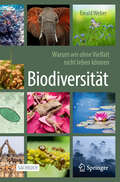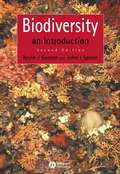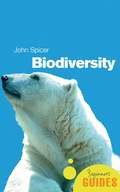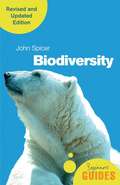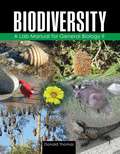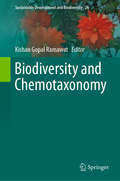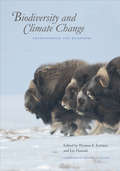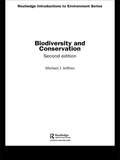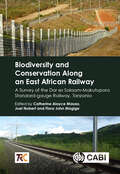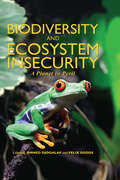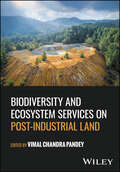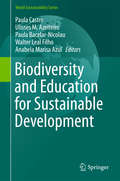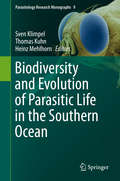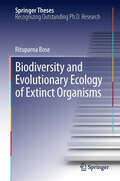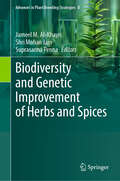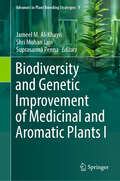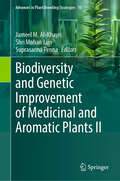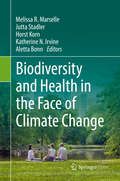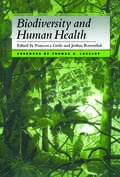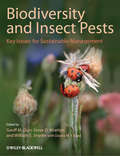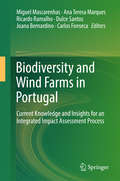- Table View
- List View
Biodiversität - Warum wir ohne Vielfalt nicht leben können
by Ewald WeberDieses Buch berichtet über ein ebenso spannendes wie aktuelles Thema an der Schnittstelle zwischen naturwissenschaftlicher Grundlagenforschung und globaler gesellschaftlicher Herausforderung: die Biodiversität. Drei Ebenen kommen hier zusammen: die Vielfalt der Arten in einem Lebensraum, die Vielfalt der Ökosysteme und Lebensräume selbst und die Vielfalt der Gene in den Lebewesen. Der Autor ist Biologe und war selbst in der Biodiversitätsforschung tätig. Er nimmt Sie mit auf eine aufregende Entdeckungsreise durch diese mannigfach vernetzte Welt. In leicht verständlicher Sprache und mit vielen anschaulichen Beispielen erklärt er komplexe Zusammenhänge und Hintergründe. Wie ist Biodiversität definiert, und mit welchen Techniken wird sie erfasst? Wie ist die immense Artenvielfalt auf der Erde entstanden, und wie entwickelt sie sich weiter? Welchen Nutzen hat die Biodiversität auf den verschiedenen Ebenen? In welchem Maße ist die Vielfalt der Arten und Lebensräume heute bedroht, und wie kann man diesem Trend entgegenwirken? Solche und ähnliche Fragen beantwortet dieses Buch, in dessen breitem Themenbogen sich die Vielfalt seines Gegenstands widerspiegelt. Die 2. Auflage des Buches berücksichtigt dabei neuste Erkenntnisse aus der Forschung und neue Entwicklungen zum Rückgang der biologischen Vielfalt. Aber auch von den zahlreichen Bemühungen, dem Verlust entgegenzuwirken, ist die Rede. Die Erfolgsgeschichten des Naturschutzes geben Anlass zur Hoffnung. Biodiversität ist faszinierend und wertvoll – tauchen Sie ein in die faszinierende Welt der biologischen Vielfalt!
Biodiversity: An Introduction
by Kevin J. Gaston John I. SpicerCLICK HERE TO DOWNLOAD ARTWORK This concise introductory text provides a complete overview of biodiversity - what it is, how it arose, its distribution, why it is important, human impact upon it, and what should be done to maintain it. Timely overview of the serious attempts made to quantify and describe biodiversity in a scientific way Acts as an easy entry point into the primary literature Provides real-world examples of key issues, including illustrations of major temporal and spatial patterns in biodiversity Designed primarily with undergraduate students and course lecturers in mind, it will also be of interest to anyone who requires an overview of, and entry to, the vast literature on these topics. All the figures included in the book are downloadable from the Blackwell Publishing website
Biodiversity: Maintenance, Function, Origin, and Self-Organisation into Life-Support Systems
by Edmundas LekevičiusSpecies are not functionally independent. From a long-term perspective, only ecosystem with a fully integrated nutrient cycle is alive. The lack of trophic autonomy should be considered one of the key factors that ensure and maintain biodiversity. The variability of abiotic conditions, both in space and in time, also creates a huge diversity of niches and subniches for genotypes and species. In addition, life maintains its essential variables (biomass and productivity) as stable as possible due to the diversity of structures (genes, macromolecules, metabolic pathways, genotypes, species, etc.): the structures that reach optima are multiplied and thus activated, while the functioning of those which lost their optima is suppressed. The facts and concepts presented in this monograph thus support the conclusions that (a) genotype and species diversity is supported by trophic specialisation (b) biodiversity helps to stabilise the functions (essential variables) of individuals, populations, and ecological communities (c) in evolution, the emergence of biodiversity is determined by heritable variation and the advantage of specialised (more effective) structures over non-specialised ones (d) biodiversity is characterised by its ability to increase itself and to organise itself into relatively consistent structures, which we call production pyramids and nutrient cycles. This book therefore provides an answer to the question "why the diversity of life is of such and such a nature".
Biodiversity: Threats and Conservation (Translating Animal Science Research)
by Rc SobtiThe term "biodiversity" or "biological diversity" describes the variety of living beings on Earth encompassing microorganisms, plants, animals, and ecosystems, such as coral reefs, forests, and deserts. In fact, it also represents a wealth of biological resources available to us. Today, instead of exploring and preserving its unmapped biodiversity, mankind has gone away from mother nature, conquering the domain through relentless exploitation. This has resulted in an ecological imbalance and thereby has posed serious threat to biodiversity. Declining biodiversity is, therefore, a concern for countless reasons. Biodiversity’s wealth of genetic information can be conserved by storing biological material from endangered species. Cell lines, gametes, and embryos are preserved so that in case a species becomes extinct or there is a need to increase the population of the species, then cloning and artificial reproductive techniques can be used to revive and reproduce the said species. The present volume discusses the biodiversity of specific animal groups, such as cnidarians and fish, as well as potential risks to and methods for conserving some of them. The following important aspects are addressed: 1. The importance of biodiversity in maintaining ecosystem balance for sustainability 2. The emerging role of biodiversity as a source of important materials, pharmaceuticals, food, and so on as such or through genetic manipulation to meet the contemporary and future challenges 3. The impact of environment degradation on biodiversity and conservation in a changing environment 4. Conventional and emerging biotechnological techniques to conserve biodiversity The book is intended for academics, scientists, and naturalists working in the fields of biology, biochemistry, biophysics, and biomedical sciences.
Biodiversity: A Beginner's Guide (Beginner's Guides)
by John SpicerIn this steadfast and yet witty guide, biologist John Spicer examines biodiversity, giving the reader an insight into the myriad of organisms that surround us.
Biodiversity: A Beginner's Guide (revised and updated edition) (Beginner's Guides)
by John SpicerOur future is closely tied to that of the variety of life on Earth, and yet there is no greater threat to it than us. From population explosions and habitat destruction to climate change and mass extinctions, John Spicer explores the causes and consequences of our biodiversity crisis. In this revised and updated edition, he examines how grave the situation has become over the past decade and outlines what we must do now to protect and preserve not just nature&’s wonders but the essential services that biodiversity provides for us, seemingly for nothing.
Biodiversity: A Lab Manual For General Biology II
by Donald R. ThomasThis lab manual is intended to accompany the General Biology II course at Southwest Tennessee Community College. This course focuses on the evolution and diversity of living organisms with attention to comparative anatomy within the vertebrate animals. The manual contains instructions for hands-on examination of specimens with minimal repetition of content found in the recommended textbook (Biology. Solomon and Berg, current edition). This format is used with the motive of saving costs for the student and encouraging the use of the text and the instructor s assistance for explaining unfamiliar vocabulary. In addition to the illustrations in this manual, students may also find photographs and anatomical diagrams of the subjects on the internet as well as in the textbook"
Biodiversity and Business: Bio Prospecting and Benefit Sharing
by Laladhas Krishna Panicker Prakash Nelliyat Oommen V. OommenThis book addresses the climate risk influencing biodiversity globally and discusses the sustainable use of biological diversity and its legal implications. The sustainable bio-prospecting will help conservation regarding the resources and livelihood support of those who conserve it from the UN CBD perspective. In mega bio-diverse countries, biodiversity provides a number of ecosystem services as well as sources of income/livelihood for millions of poor and they are also the home of a vast repository of traditional knowledge (TK) associated with biological resources which can be translated therapeutically. As for Climate risks, the risks related to unscientific management and use of biodiversity are far more compared to the benefits for society and business and therefore, reducing pressure on biodiversity and developing a sustainable commodity supply chain is essential for both the industry and the governments. Exploring and further mining of the vastness of biodiversity potential, in the marketplace, has been a subject of great consideration among biotechnologists, food processors, health care specialists and the like, as they are real money-spinners. The book will be of interest to researchers/College/ University students interested in ecology and biodiversity conservation worldwide
Biodiversity and Chemotaxonomy (Sustainable Development and Biodiversity #24)
by Kishan Gopal RamawatPlant classifications are based on morphological characters and it is difficult, particularly in small plants and grasses, to identify these below generic level on the basis of these characters using a dissecting microscope. Plant species have intra- and inter-specific variation in secondary metabolites which can be utilized as marker compounds for identification and classification of plants. Secondary metabolites are produced as a result of primary metabolism and the production of these compounds not only involves several genes but also it is an energy dependent process. Hence these products cannot be considered as insignificant for the plant and the environment. Modern tools of molecular biology and secondary metabolites present in them can definitively decide about classification of plants. Absence of correct identification of plant is associated to many problems of resource utilization. Due to wide availability of these tools, interest has revived in systematics and correct classification of plants based on these parameters for their sustainable utilization and resource management. The purpose of this book is to assess the potential of phytochemical and molecular tools in the systematic and classification of plants. The topics covered include species concept, barcoding and phylogenetic analysis, chemotaxonomy use of polyketides, carotenes, cuticular wax, volatile oils, biodiversity of corals, metazoans, Ruta and Echinocereus. It provides comprehensive and broad subject-based reviews, useful for students, teachers, researchers, and all others interested in the field. The field has been kept wide and general to accommodate the wide-ranging topics. This book will be useful to agriculturists, chemists, botanists, industrialists, and those involved in planning of crop plants.
Biodiversity and Climate Change: Transforming the Biosphere
by Thomas E. Lovejoy Lee Hannah Edward O. WilsonAn essential, up-to-date look at the critical interactions between biological diversity and climate change that will serve as an immediate call to action The physical and biological impacts of climate change are dramatic and broad‑ranging. People who care about the planet and manage natural resources urgently need a synthesis of our rapidly growing understanding of these issues. In this all‑new sequel to the 2005 volume Climate Change and Biodiversity, leading experts in the field summarize observed changes, assess what the future holds, and offer suggested responses. From extinction risk to ocean acidification, from the future of the Amazon to changes in ecosystem services, and from geoengineering to the power of ecosystem restoration, this book captures the sweep of climate change transformation of the biosphere.
Biodiversity and Conservation
by Michael J. JeffriesThis revised second edition provides an introductory guide through the maze of interdisciplinary themes that comprise 'biodiversity.' It combines biological sciences with insights into the origins, variety and distribution of biodiversity, analysis of the social and political context, and the threats to, and opportunities for, the survival of natural systems. Whilst retaining its existing structure, this updated new edition reflects advances that have demonstrated the importance of living systems as drivers of environmental services vital to human health and security. The final chapter has been revised to tackle more explicitly the contrasting approaches to conservation, and throughout, the book has been updated to reflect new research and developments. With highly original international case studies and ample illustrations to explain difficult topics clearly, this excellent book remains the only introductory text which brings together the full range of theory and practice of ‘biodiversity’ and ‘conservation’.
Biodiversity and Conservation Along an East African Railway: A Survey of the Dar es Salaam-Makutupora Standard-gauge Railway, Tanzania
by Edmond Alavaisha S. Zainabu Bungwa Philbert Anitha Byabato Deusdedith Fidelis Elikana John Jasson John Julius Mohamed Kibaja Heriel Moshy Athumani Fatina Mturi R. Juma Mwangi Henry Ndangalasi Wilrik Ngalasoni Alberto Bruno Nyundo Chacha Werema Felix A. Shayo N A MbwamboIt is well known that infrastructure development projects can boost the economy and reduce the cost of trade in both developing and developed economies, however, infrastructure projects can also cause biodiversity loss. This book is the result of an important biodiversity survey conducted along an East African railway in Tanzania. The building of the railway, still under construction, has already led to habitat loss, habitat degradation and landscape change which may have affected biodiversity. The book includes recommendations to mitigate the effect of railway construction by protecting biodiversity and ecosystem services which could have major implications across Africa and other regions. The area covered by the survey focuses on the Standard Gauge Railway (SGR) running through the Pugu and Ruvu South Forest Reserves towards Maktupora-Dodoma, plus data on large mammals through to Isaka-Shinyanga. The Pugu forests boast high biodiversity of both flora and fauna, some of which are endemic to the area. There are both plant and animal species that are of major conservation concern so there is urgent need to consolidate information to help formulate suitable conservation measures. The data collected covers plants, invertebrates, amphibians, birds, and mammals for terrestrial and aquatic environments along the SGR. This work is timely as there are many more ongoing SGR construction projects in Tanzania and across Africa, as such construction activities inevitably involve some habitat modification and destruction that may have a negative impact on biodiversity. National and international scientists, decision and policy makers, as well as ecologists and conservation managers involved in large infrastructure projects will find this book invaluable. The book provides baseline information and can be used as a case study for other infrastructure development projects around the world.
Biodiversity and Conservation of Woody Plants (Sustainable Development and Biodiversity #17)
by M. R. Ahuja S. Mohan JainThis book provides complete, comprehensive, and broad subject-based reviews for students, teachers, researchers, policymakers, conservationists, and NGOs interested in the biodiversity and conservation of woody plants. Forests cover approximately 31 percent of the world's total landmass; 93 percent is natural forest and only 7 percent consists of planted trees. Forest decline is progressing at an alarming rate worldwide. In addition to human activities (logging, deforestation, and exploiting forest lands for agriculture and industrial use), a number of other factors - including pests and diseases, drought, soil acidity, radiation, and ozone - are cumulatively contributing to global forest decline. The present situation forces us to focus on forest conservation strategies for the present and future. Gene conservation and maintaining genetic diversity in forest ecosystems are crucial to the preservation of forest genetic resources. This calls for integrated action to implement both the in situ (on site) preservation of forest stands and ex situ (distant from the original site) strategies for the conservation of woody plants' genetic resources. Selected priority areas include: 1) assessing patterns of genetic diversity and threats, 2) understanding the biological processes regulating genetic diversity, 3) assessing the impact of human activities and climate change on genetic diversity, and 5) finding methods for prioritizing species and populations for the conservation of forest trees genetic resources. All chapters were written by leading scientists in their respective fields, which include: woody plant diversity, ecology and evolution; assessment of genetic diversity in forest tree populations; conservation planning under climate change; and in situ and ex situ strategies, including biotechnological approaches, for the conservation of woody plants genetic resources.
Biodiversity and Ecosystem Insecurity: A Planet in Peril
by Ahmed Djoghlaf Felix DoddsBiodiversity and Ecosystem Insecurity provides an authoritative and comprehensive assessment of the threats presented to human security and well-being by the loss of ecosystems and biodiversity recently confirmed as one of the critical 'planetary boundaries' that has already been exceeded. Contributors examine the current trends and state of biodiversity globally, the drivers of biodiversity loss including climate change and economic and population pressures, and the mechanisms and policies needed for conserving and restoring biodiversity in the future. Strong emphasis is placed throughout on the fundamental importance of placing a realistic economic value on nature and the services that ecosystems provide if we are to manage our natural resources successfully; and also on the crucial role of international institutions and government policies achieving this goal. As the recent high-profile meeting of the Convention on Biological Diversity in Nagoya, Japan, underlined, the scale and pace of the destruction of natural habitats and species imperil us all. This volume is an invaluable resource for conservationists, students and those in the private and public sectors concerned to redress the damage being done to the natural world.
Biodiversity and Ecosystem Services on Post-Industrial Land
by Vimal Chandra PandeyGuide to post-industrial site restoration and re-establishment of rich communities of plant species for the provision of key ecosystem services In line with the UN sustainable development goals, Biodiversity and Ecosystem Services on Post-Industrial Land is an expert guide to ecological restoration of post-industrial lands, explaining how to re-introduce biodiversity and ecosystem services by implementing natural processes in the rehabilitation of disturbed sites. It covers both the initial stages associated with the improvement of physicochemical and biological substrate characteristics as a precondition for continuous vegetation, as well as the subsequent re-establishment of rich communities of plant species and how these communities may be optimized for their biodiversity and ecosystem services such as pedogenesis, nutrient cycling, habitation for other organisms, food plants for herbivores, carbon sequestration, and aesthetic value. Case studies of successful restoration of industrial sites from Asia, Africa, North and South America, and Europe, which include coal and mineral mining sites, oil drilling sites, and dumpsites, complement the conceptual part of the text and demonstrate how to put the theory into practice. Written by an experienced researcher in the field, Biodiversity and Ecosystem Services on Post-Industrial Land includes information on: Mining sustainability in arid zones, aromatic plants for phytoremediation, and spontaneous flora growth on metalliferous sites Resilience of plant diversity, ecosystem services from rehabilitated waste dumpsites, and plantation forestry for eco-restoration Soil biodiversity and plant-microbe interactions, afforestation of former asbestos mines, and bauxite mine restoration and management Role of the local government in re-use of sites, restoration of wetlands in oil and gas exploration areas, and carbon sequestration in revegetated coal mine soil Biodiversity and Ecosystem Services on Post-Industrial Land is an essential guide for environmental managers, scientists, ecologists, and engineers tasked with restoring post-industrial sites, managers in mining, oil, gas, and other heavy industries, and NGOs involved in sustainable land use.
Biodiversity and Education for Sustainable Development (World Sustainability Series)
by Walter Leal Filho Ulisses M. Azeiteiro Paula Castro Paula Bacelar-Nicolau Anabela Marisa AzulThis book gathers interdisciplinary reflections fromresearchers, educators, and other experts on the subject of biodiversity closerto education and learning. The book also highlights its role as an added valueto strategic principles for healthy ecosystems and sustainable humandevelopment. It promotes critical thinking and foster practices and attitudesfor Education for Sustainable Development reconciling education with principlesof human behaviour and nature. Readers especially find this book a timelyresource in light of the Strategic Plan for Biodiversity 2011-2020, the AichiTargets, and the new EU biodiversity strategy "Our life insurance, our naturalcapital: an EU biodiversity strategy to 2020". Along with the challenge ofecosystems and public health, biodiversity conservation is essential forhumanity's continued security and sustainability, as it touches on all aspectsof people's lives.
Biodiversity and Evolution of Parasitic Life in the Southern Ocean (Parasitology Research Monographs #9)
by Sven Klimpel Heinz Mehlhorn Thomas KuhnThe Southern Oceans including Antarctic regions are peculiar and very sensitive water biotopes, where animal life and species interrelations are only poorly investigated. Especially the influence of parasites on their host species needs intensive consideration in times of global warming and worldwide pollution. Both factors may influence the finely balanced interrelationships between parasites and endangered hosts especially in specialized regions such as Antarctica. Before this background the present book offers a broad spectrum of important parasite-host interrelations in times of ecosystem changes written by experienced and renown international specialists.
Biodiversity and Evolutionary Ecology of Extinct Organisms (Springer Theses)
by Rituparna BoseIncreasing rate of species extinction in the present day will lead to a huge biodiversity crisis; eventually, this will lead to the paucity of non-renewable resources of energy making our Earth unsustainable in future. To save our mother planet from this crisis, studies need to be performed to discover abundant new fossil sites on Earth for continued access to oil-rich locations. Most importantly, a holistic approach is necessary in solving the present problem of biodiversity loss. This book presents newly developed quantitative models in understanding the biodiversity, evolution and ecology of extinct organisms. This will assist future earth scientists in understanding the natural and anthropogenic causes behind biodiversity crisis and ecosystem collapse. In addition, this study would be of great interest to exploration geologists and geophysicists in potentially unraveling natural resources from our sustainable Earth.
Biodiversity and Genetic Improvement of Herbs and Spices (Advances in Plant Breeding Strategies #8)
by Shri Mohan Jain Jameel M. Al-Khayri Suprasanna PennaThe herbs and spices plants have immensely benefited humankind since ancient times for therapeutic, cosmetic, and nutritional properties. The wealth of information on genetic resources, breeding, conservation, propagation, cultivation, and biotechnological strategies is crucial for plant improvement. This volume consists of 19 chapters covering research advances in conventional and modern breeding technologies of various important herbs and spices individually, including Basil, Bay leaf, Cinnamon, Coriander, Dill, Lemongrass, Long pepper, Nutmeg, Onion, Oregano, Parsley, Pepper, Saffron, Sage, Sesame, Tarragon, Thyme, Common turmeric, and Scentless turmeric. Chapters are written by globally renowned scientists and subjected to a rigorous review process to ensure quality presentation and scientific precision. Each chapter has an introduction covering related backgrounds and provides an in-depth discussion of the subject supported with high-quality color photos, illustrations and relevant data. The chapter concludes with future research directions and pertinent references to facilitate further reading. The book is an excellent reference source for plant breeders, biotechnologists and geneticists engaged in breeding and improvement. The book is suitable for both advanced undergraduate and postgraduate students specializing in agriculture, biotechnology, and molecular breeding as well as for seed companies.
Biodiversity and Genetic Improvement of Medicinal and Aromatic Plants I (Advances in Plant Breeding Strategies #9)
by Shri Mohan Jain Jameel M. Al-Khayri Suprasanna PennaThe medicinal and aromatic plants have immensely benefited humankind since ancient times for therapeutic, cosmetic, and nutritional properties. The wealth of information on genetic resources, breeding, conservation, propagation, cultivation, and biotechnological strategies is crucial for plant improvement. This volume consists of 12 chapters covering research advances in conventional and modern breeding technologies of various medicinal and important aromatic plants individually, including Brahmi, Barberry, Betel, Blond plantain, Caper, Chinese woad, Common hop, Damask rose, Deadly, Echinacea, Ginkgo, and Gymnema. Chapters are written by globally renowned scientists and subjected to a rigorous review process to ensure quality presentation and scientific precision. Each chapter has an introduction covering related backgrounds and provides an in-depth discussion of the subject supported with high-quality color photos, illustrations and relevant data. The chapter concludes with future research directions and pertinent references to facilitate further reading. The book is an excellent reference source for plant breeders, biotechnologists and geneticists engaged in breeding and improvement. The book is suitable for both advanced undergraduate and postgraduate students specializing in agriculture, biotechnology, and molecular breeding as well as for seed companies.
Biodiversity and Genetic Improvement of Medicinal and Aromatic Plants II (Advances in Plant Breeding Strategies #10)
by Shri Mohan Jain Jameel M. Al-Khayri Suprasanna PennaThe medicinal and aromatic plants have immensely benefited humankind since ancient times for therapeutic, cosmetic, and nutritional properties. The wealth of information on genetic resources, breeding, conservation, propagation, cultivation, and biotechnological strategies is crucial for plant improvement. This volume consists of 13 chapters covering research advances in conventional and modern breeding technologies of various medicinal and important aromatic plants individually, including Indian ginseng, Datura, Licorice, Marjoram, Moringa, Neem, Opium poppy, Patchouli, Persian shallot, Plumbago, St John's-wort, Stevia, and Upastree resin. Chapters are written by globally renowned scientists and subjected to a rigorous review process to ensure quality presentation and scientific precision. Each chapter has an introduction covering related backgrounds and provides an in-depth discussion of the subject supported with high-quality color photos, illustrations and relevant data. The chapter concludes with future research directions and pertinent references to facilitate further reading. The book is an excellent reference source for plant breeders, biotechnologists and geneticists engaged in breeding and improvement. The book is suitable for both advanced undergraduate and postgraduate students specializing in agriculture, biotechnology, and molecular breeding as well as for seed companies
Biodiversity and Health in the Face of Climate Change
by Aletta Bonn Horst Korn Jutta Stadler Melissa R. Marselle Katherine N. IrvineThis open access book identifies and discusses biodiversity’s contribution to physical, mental and spiritual health and wellbeing. Furthermore, the book identifies the implications of this relationship for nature conservation, public health, landscape architecture and urban planning – and considers the opportunities of nature-based solutions for climate change adaptation. This transdisciplinary book will attract a wide audience interested in biodiversity, ecology, resource management, public health, psychology, urban planning, and landscape architecture. The emphasis is on multiple human health benefits from biodiversity - in particular with respect to the increasing challenge of climate change. This makes the book unique to other books that focus either on biodiversity and physical health or natural environments and mental wellbeing. The book is written as a definitive ‘go-to’ book for those who are new to the field of biodiversity and health.
Biodiversity and Human Health
by Bhaswati Bhattacharya Mary Campbell Jensa Bell Michael Boyd Eric Chivian Paul CoxThe book provides a common framework for physicians and biomedical researchers who wish to learn more about environmental concerns, and for members of the environmental community who desire a greater understanding of biomedical issues.
Biodiversity and Insect Pests: Key Issues for Sustainable Management
by Geoff M. Gurr Stephen D. Wratten William E. SnyderBiodiversity offers great potential for managing insect pests. It provides resistance genes and anti-insect compounds; a huge range of predatory and parasitic natural enemies of pests; and community ecology-level effects operating at the local and landscape scales to check pest build-up. This book brings together world leaders in theoretical, methodological and applied aspects to provide a comprehensive treatment of this fast-moving field. Chapter authors from Europe, Asia, Africa, Australasia and the Americas ensure a truly international scope. Topics range from scientific principles, innovative research methods, ecological economics and effective communication to farmers, as well as case studies of successful use of biodiversity-based pest management some of which extend over millions of hectares or are enshrined as government policy. Written to be accessible to advanced undergraduates whilst also stimulating the seasoned researcher, this work will help unlock the power of biodiversity to deliver sustainable insect pest management. Visit www.wiley.com/go/gurr/biodiversity to access the artwork from the book.
Biodiversity and Wind Farms in Portugal: Current knowledge and insights for an integrated impact assessment process
by Miguel Mascarenhas Ana Teresa Marques Ricardo Ramalho Dulce Santos Joana Bernardino Carlos FonsecaThis book presents a review of the state-of-the-art knowledge on the interactions between biodiversity and wind energy development, focused on the Portuguese reality. The volume addresses the particularities of the impact assessment procedures in Portugal, contrasting it with the international practices and presenting its main findings by covering the following broader themes: i) evaluation of spatial and temporal dynamics of wildlife affected by wind farms, including birds, bats and terrestrial mammals (in particularly Portuguese wolf population); ii) the methodologies used to assess impacts caused by this type of developments in biodiversity; iii) the best practice methodologies to implement an adaptive management approach to reconcile biodiversity and wind farms. The knowledge presented in this book was gathered through the research and development activities developed by Bioinsight company (former Bio3 company) during the last 13 years and partially funded by a R&D project designated as "Integrated solutions for biodiversity management at wind farms: reduce and compensate bird and bat mortality" (acronym: Wind & Biodiversity), co-funded by the European Regional Development Fund (FEDER), under the Regional Operational Programme of Centre (Mais Centro). This volume fills a void in the literature as a book giving insights on the best practices to install and manage a wind farm from a biodiversity management point of view, while establishing a commitment between economic sustainability and biodiversity conservation.
